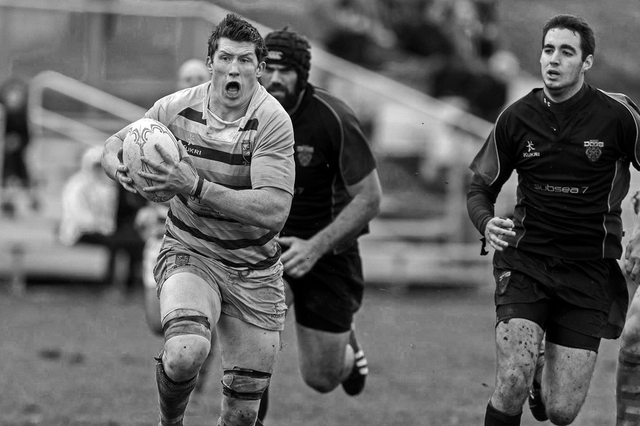Swilers Rugby Club: 40 Years of Rugby on the Rock
Written By: Brock Smith
There’s something about Swilers rugby that’s tough to quantify, to put into words.
Chiseled and toughened by the harsh winds and the salt from the ocean breeze, St. John’s rugby players are a hardier stock than most; for 80 minutes, they’re notoriously fearsome, inspired competitors.
Sleet. Snow. Gale force winds. They play through it all. Rugby weather, it’s called.
However, the moment the final whistle blows, the twinkle returns to their eyes, wry grins return to their faces, hands are extended, and the east coast hospitality kicks into gear.
Those who have toured to the City of Legends may have sustained their fair share of bumps and bruises over the years, but they leave the Rock with much more than the odd scrape.
They return home having experienced Swilers rugby: one of the great idiosyncratic, down-to-earth club rugby atmospheres on offer in Canada.
No other club in Newfoundland is older.* No other club in Newfoundland is more well-known abroad. Ask around, and there’s no other club quite like it.
And it’s been going strong for 40 years.
==========
While rugby has a deep-rooted history in Newfoundland (documented matches date back as far as the late 19th century), sport in the region entered a renaissance period of revitalized interest throughout the early 1970s, prompting calls for an organized provincial league.
Those calls were answered in 1977, when a four-team league was launched. One of the entries into the fledgling competition would be the Swilers Rugby Club, named for the Newfoundland slang term for a seal hunter.
It was the resolve of club founder Dr. Noel Browne, a physician and rugby stalwart from Galway, Ireland, that built the club from the ground up. Under his leadership, the club – a ragtag group of British and Irish expatriates and keen locals eager to learn from Dr. Browne – went undefeated in that inaugural season, en route to earning the first Newfoundland Rugby Union championship.
“Forty years on, I think we continue to channel that fighting spirit from our original team,” says Morgan Lovell, executive director of the Swilers Rugby Club. “Our foundations were built from many different backgrounds coming together with a strong desire to play, and our club hasn’t lost that passion.”
Lovell himself is a Welsh expat; a rugby opportunity brought him to St. John’s in 2008, and after falling for the city and the club, he’s never thought about leaving.
“Coming to Newfoundland was a rugby decision,” says Lovell. “I came over to play, and then I got hooked into coaching. I’ve been with the Swilers for eight years, and they’ve made Newfoundland my home.”
Lovell imagines many of the original Swilers felt the same way about the club as he does now, possessing a feeling of camaraderie that transcends generational and geographical gaps.
“Our members feel a real strong connection to the club,” he says. “Even in clubs in Wales, I didn’t see this kind of connection, and it means a lot to us. Our connection to our community, and to each other, is pure.”
“We take a certain pride in the fact that we’ve come from all walks of life to become one of the most well-known clubs in Canada. I’ve been involved with a lot of rugby clubs before I came to Canada, and this is a unique feeling here.”
But how has a club from a town with a population of just over 100,000 people risen to Canadian prominence?
Ask most members of the Swilers, and they’ll give you the same three words: Dr. Pat Parfrey.
The world-renowned physician and Irish rugby standout arrived in Newfoundland in 1984, and after being appointed as the Swilers’ head coach the following year, Dr. Parfrey instilled a tradition of touring that has been woven into the very fabric of the club.
“We travel every year for the Al Charron Cup (Eastern Canadian Club Championship) when we don’t host the tournament, but in keeping with the vision Dr. Parfrey established all those decades ago, we also try to travel every two or three years on international tours,” says Lovell. “We were in Italy this past year, and Germany two years before that.”
Lovell notes that when the Swilers go on tour, they feel a responsibility to proudly represent the Rock abroad.
“There’s a lot of pride involved in representing Newfoundland,” he adds. “I’ve never lived in any other province in Canada, but I find that the allegiance and pride in our province is greater here than in most other areas in Canada. It’s almost as if we’ve created our own little international brand, and it helps when we welcome international clubs back to St. John’s. We’re a known quantity outside of North America.”
The hospitality that the Swilers extend to incoming touring sides, as well as the sterling reputation the club has developed in mainland Canada and abroad, has been a result of a positive, inclusive culture that keeps its membership coming back each Saturday.
“The club is the reason why I’ve started playing rugby and enjoyed it so much,” says Canadian international Pat Parfrey Jr. “It’s the type of team that wants you to come back every weekend to play a game of rugby because all the club members are so supportive.”
Parfrey, the son of Dr. Parfrey, has been the most prolific Swilers-developed player over the past decade, having earned 17 caps with Canada’s national team since his debut in 2013.
“I guess the Parfrey name is really solid within the Swilers club,” the 26-year-old chuckles, playfully stating the obvious. “All my brothers played for Swilers before me, and after all the work my parents have done with the club, it’s become part of our family. It’s been such a huge presence in my life.”
The standout fly-half can recall the first match he played for the Swilers; it was a local tilt against St. John’s rivals Vandals Rugby Club in 2005, when the 15-year-old Parfrey suited up in a senior men’s match.
“It was a moment I’ll never forget, a moment of adrenaline and passion that’s kept me wanting to play ever since,” recalls Parfrey. “I know a lot of my friends who I grew up playing rugby with – friends I made while on that team – wouldn’t play rugby anymore if wasn’t because the club’s camaraderie. From the first time I stepped on the pitch, everyone shows up for each other. I’ve made lifelong friends with the Swilers.”
Parfrey is currently on tour in Europe as part of Canada’s autumn international test window, and is joined by fellow Newfoundland product Ciaran Hearn, who rose through the ranks of the Conception Bay South outfit Baymen Rugby Club.
“With Newfoundland, and specifically our province’s four clubs, we need to push each other as hard as possible if we’re going to continue producing elite-level east coast rugby players,” adds Parfrey. “I think Swilers has set the gold standard in the east coast for quite a bit, and as a result, the onus is on our club to be Newfoundland’s top producer of young talent. We strive to be the best.”
==========
While the Swilers’ 40th season went by with little fanfare – one of the club’s quirky traditions is to celebrate a milestone anniversary the year after the anniversary occurs – the St. John’s outfit has big plans to commemorate its ruby jubilee in the coming year. “I’m not entirely sure why we do it, but we celebrate the year after,” laughs Lovell. “What can I say? We’re a different club.”
The club’s 40th anniversary celebration will be held in St. John’s next August, centred around a match with touring Irish club side Cork Constitution FC – a team that hails from the same part of Ireland as Dr. Parfrey.
“It’s the kind of match that will see all 300 of our members come out to support our club, and to welcome Cork to St. John’s,” says Lovell. “It will be a celebration of all-things rugby, especially as we welcome back many of our alumni for the festivities.”
The Swilers are also in the midst of fundraising for badly-needed pitch renovations set to begin next year.
“It’s no secret that the Swilers field doesn’t have the best reputation as a playing surface, so we’re trying to shed that association by building a top-class field,” says Lovell. “It will include a new irrigation system, a new scoreboard, and new fencing around the outside.”
The price tag for the field’s face-lift? It won’t be cheap.
“We’re looking at spending around $800,000 on the new pitch. It’s costly, but it needs to be done, and it will be the legacy piece of our 40th anniversary.”
With the new field expected to be complete in time for the 2019 season, the club hopes that a pristine playing surface will make St. John’s an even more desirable touring destination.
“We’ve got a really nice facility now, a great clubhouse, quality training areas, and a multi-million-dollar sports complex next door that we can use,” says Parfrey. “The last piece of the puzzle is a fresh pitch, which will go leaps and bounds to attract quality games for the Swilers club and the Atlantic Rock.”
The new field, as Lovell notes, will pay homage to the club’s rich history, while looking ahead to its bright future.
“There’s a lot of people in the community who are really proud of what we’ve built and what’s been achieved here, but we’re not done yet,” adds Lovell. “We want to continue the legacy that Noel and Pat started. We want to continue showcasing our club, and all the pride that comes with being a Swiler.”


